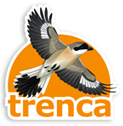
Exogenous juvenile Black Vulture (it was neither released nor born in the area). © Boumort – Alinyà Team
On the tracking carried out last July 2013 at the National Hunting Reserve (NHR) of Boumort, 33 different black vultures were monitored and the third chick born in 2013 was equipped with a GPS transmitter.
From those 33 black vultures, 24 were released or born in the wild within the reintroduction programme, 2 were coming from Cévennes (France) and at least 7 individuals were exogenous from Iberian origin. On July 22 the maximum number of black vultures was observed in only one day: 22 individuals.
Besides the stable and continued presence of the four pairs that this season started reproduction in the NHR of Boumort, it is worth noting the strong attachment to the area of the five males released on March 1 in Boumort. The fifth and sixth pairs stay along the periphery of the NHR.
The three chicks reached the size they will have when starting their first flights. Although two of them were given enough food by their parents to reach it, one of them (the one from Bruna and Corneli) needed supplementary food because of the gradual decrease of the parenteral feeding as well as the decrease of the presence of the female in the nest. On the other hand, on July 17 the third chick born in this season was marked, when it was 84 days old. It was equipped with a GPS transmitter and a plastic ring that can be read at a distance without disturbing the bird.

New platform built in last July to stimulate black vultures to nest in that tree. © Boumort – Alinyà Team
The reintroduction project of the Black Vulture in the Pyrenees is promoted by the Departament d’Agricultura, Ramaderia, Pesca, Alimentació i Medi Natural de la Generalitat de Catalunya and by the Fundació Catalunya – La Pedrera. GREFA and Trenca are involved in the assisment and implementation of the Project, toghether with the Alinyà Natural Site staff and the rangers of the NHR of Boumort. The Estació Biològica del Pallars Jussà carries out several educational actions related to the project.
For further information on this project, please check the section Reintroduction of the Black Vulture (Aegypius monachus) in the Pyrenees on this website.



